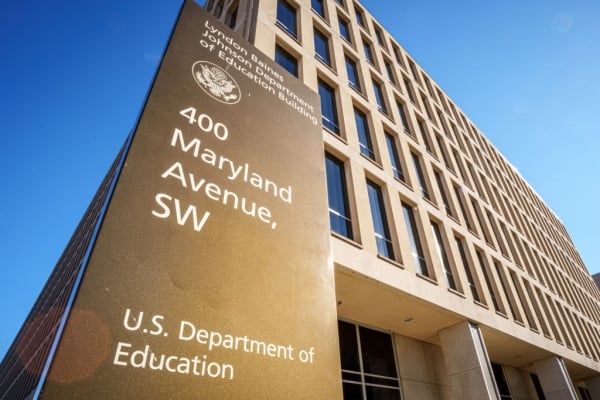Republicans’ long-sought goal of shuttering the Education Department got a boost this week as several media outlets reported the Trump administration was finalizing plans for an executive order to wind down the agency.
Trump added to the speculation, telling reporters Tuesday he wanted his education secretary nominee, Linda McMahon, to put herself out of a job. Then, on Wednesday, House Speaker Mike Johnson, a Louisiana Republican, said getting rid of the department is “an idea whose time has come.”
The specifics and timing of the executive order are still unclear, though media reports say the directive could instruct department officials to shut down some programs not directly approved by Congress or come up with a plan to move functions to other departments in the federal government. At the very least, the Trump administration wants to see a much smaller version of the department, particularly because only Congress can actually eliminate the agency.
More than 4,000 people currently work for the department, which was created in 1979. In fiscal year 2024, the department had a $80 billion discretionary budget. Its spending makes up just over 2 percent of the federal budget.
Some conservative think tanks have been planning for the department’s demise for years. Most recently, Project 2025, a policy manual for the second Trump administration, detailed how to dismantle the agency—from which offices to shutter to which ones to move.
While those plans delve into all the department’s functions, much of the recent commentary about why the agency could go revolves about its role in K-12 education, largely ignoring how shutting it down could affect higher education.
But the federal government is deeply embedded in higher education, thanks to the billions it sends to colleges and universities each year. Unwinding the department would be complex and likely disruptive for colleges and the students they serve.
“That’s not something our community could handle at this point in time,” said Karen McCarthy, vice president of public policy and federal relations at the National Association of Student Financial Aid Administrators, on an episode of the organization’s podcast this week. “From our perspective, it’s highly unlikely that such a transition would be quick or smooth.”
As talks ramp up about the department’s future, here are the five key roles the department plays in higher education—and what could happen to them if the agency is shuttered.
Doles Out Billions in Grants and Loans
The department’s wide-ranging role in federal financial aid is one of its most important functions for higher education. The botched rollout of the 2024–25 federal aid application showed just how critical the system is to colleges and students.
Each year, the Education Department issues about $100 billion in student loans and doles out more than $30 billion in Pell Grants to more than six million low-income students. More than 5,000 colleges and universities are eligible for federal financial aid.
The department’s Office of Federal Student Aid manages the government’s $1.7 trillion student loan portfolio, oversees contractors who service those loans, carries out many of the regulations related to higher education and holds colleges accountable. Under the Biden administration, for example, FSA issued $61.7 million in fines and cut off aid to 35 colleges for violating federal law and rules.
The Trump administration hasn’t said what would happen to federal financial aid programs, or to the more than 1,600 employees who work for the Office of Federal Student Aid, if the department goes away. But some conservative plans recommend moving the whole system to the Treasury Department.
Proponents argue that moving the system to the Treasury makes sense given that the department already deals with money and lending. Additionally, they say the switch shouldn’t be too disruptive or leave students and colleges worse off. Critics of that plan disagree and question whether the Treasury has the capacity to administer the federal student aid program.
Enforces Students’ Civil Rights
While federal financial aid is key to helping students access college, the department’s Office for Civil Rights helps to ensure they are protected from discrimination once on campus.
The OCR can have a direct impact on students and colleges through investigations of complaints or guidance that prompts institutions to change their policies or rethink their civil rights offices. Colleges watch the agency’s actions closely to avoid running afoul of federal law.
In recent years, the office has seen a record number of complaints from students who allege violations of their civil rights, though the agency has struggled to keep up with the growing caseload. Biden administration officials pleaded with Congress last spring for more funding to hire 86 employees who could investigate complaints. As of last March, 557 employees worked for OCR, according to department budget documents.
The office received 22,687 complaints in fiscal year 2024, and the Biden administration projected that number to grow to nearly 24,000 in 2025. Most of the complaints in the past year related to sex-based discrimination, while 37 percent alleged discrimination based on disability. In many cases, seeking help from the federal office can be a last resort for students.
Project 2025 recommended moving OCR to the Justice Department and limiting enforcement to litigation.
Manages Grant Programs
The Education Department sends millions of dollars appropriated by Congress to colleges and universities that help to support student success, childcare on campus and other priorities for lawmakers.
In fiscal 2024, Congress allocated $3.3 billion toward higher education programs. That includes a $400 million fund to directly support historically Black colleges and universities as well as a $229 million grant program for Hispanic-serving institutions.
The department also spends about $2.14 billion on Federal Work-Study and supplemental grants to directly support low-income students.
Some institutions rely on federal support to stay open. For instance, Gallaudet University, a school for the Deaf in Washington, D.C., gets its own line item in the federal budget. The university was created by Congress and received $167.3 million in fiscal 2024, which was about 65 percent of Gallaudet’s annual revenues, Forbes reported this week.
Trump sent a shock wave through higher ed last week when his administration threatened to freeze all federal grants and loans. College administrators and lobbyists representing them warned of devastating consequences if that source of funding was turned off.
While a federal judge blocked the freeze from taking effect, the Education Department is reviewing many of the grant programs for compliance with Trump’s recent executive orders that target diversity, equity and inclusion. That review could threaten to shut off some of the programs, though technically only Congress has that authority.
Gathers Data on Students and Institutions
Researchers and policymakers rely on reams of data that the Education Department collects about students and institutions in order to better understand higher ed. As some federal databases have gone dark in recent weeks, some advocates and researchers have worried about the future and security of the department’s data.
From annual surveys conducted by the National Center for Education Statistics to the National Student Loan Data System, the data offers insights into student enrollment, graduation rates, earnings, student lending and more. In 2015, the department made that data more accessible when it launched the College Scorecard.
The future of those databases is unclear if the department goes away. Project 2025 and other analysts have recommended moving the National Center for Education Statistics to other agencies—the Bureau of Labor Statistics, perhaps, or the Department of Commerce’s Census Bureau.
But few proposals suggest getting rid of the data-collection responsibilities altogether. In fact, Project 2025 declares that the federal government’s only role in education policy should be “that of a statistics-gathering agency that disseminates information to the states.”
Oversees Colleges and Universities
The federal government works with states and accreditors to oversee colleges and universities—a three-pronged system referred to as the triad. Getting rid of the Education Department would throw the triad into flux. That would likely mean less red tape for colleges but fewer protections for students.
The department recognizes accreditors who in turn recognize colleges. Institutions can only access federal financial aid if they are accredited by a department-recognized accrediting agency and have the necessary approval from state authorizing agencies.
The Biden administration sought to require accreditors to set benchmarks for student achievement and give states more authority over distance education. Neither of those proposals moved forward, but the push shows the federal government’s role in overseeing other members of the triad in addition to colleges.
Project 2025 proposed to remove accreditors from the triad or give states more authority to authorize accreditors, breaking the federal government’s hold over the process.







